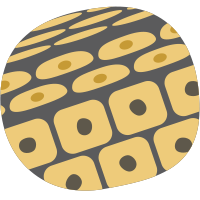
Dermal Cell News
Dermal Cell News is an online resource highlighting the latest research about wound healing, skin disorders, and dermal cancers.
Living Artificial Skin: Photosensitizer and Cell Sandwiched Bacterial Cellulose for Chronic Wound Healing
[Advanced Materials] Inspired by the bio-functionality of natural skin, investigators bioengineered an artificial skin with bacterial cellulose sandwiched between photosensitizers and functionalized living cells. The artificial skin was non-toxic, biocompatible, and accelerated the healing process of infected diabetic wounds
Bioengineered MSCCxcr2 Transdifferentiated Keratinocyte-Like Cell-Derived Organoid Potentiates Skin Regeneration Through ERK1/2 and STAT3 Signaling in Diabetic Wound
[Cellular And Molecular Life Sciences] 3D skin organoids generated using MSCCxcr2-derived keratinocyte-like cells upon grafting in a relatively avascular and non-healing wounds of type 2 diabetic transgenic mice resulted in a significant enhancement in the rate of wound closure by increased epithelialization and endothelialization.
A Frog Skin-Derived Peptide Targeting SCD1 Exerts Radioprotective Effects Against Skin Injury by Inhibiting STING-Mediated Inflammation
[Advanced Science] 26 increased peptides were identified in skin tissues of frogs (Pelophylax nigromaculatus) exposed to electron beams, among which four promoted the wound healing of irradiated skin in rats.
ASH2L Mediates Epidermal Differentiation and Hair Follicle Morphogenesis via H3K4me3 Modification
[Journal Of Investigative Dermatology] Scientists constructed a mouse model of specific ASH2L deletion in epidermal progenitor cells and investigated its effect on the development of mouse epidermal lineage. Deletion of ASH2L in epidermal progenitor cells caused thinning of the suprabasal layer of the epidermis and delayed hair follicle morphogenesis in newborn mice.
Generation of Two iPSC Lines From Patients with Inherited Central Core Disease and Concurrent Malignant Hyperthermia Caused by Dominant Missense Variants in the RYR1...
[Stem Cell Research] Scientists generated iPSC lines from two patients with central core disease and malignant hyperthermia caused by dominant RYR1 variants within the central region of the protein. Both lines displayed typical iPSC morphology, uniform expression of pluripotency markers, trilineage differentiation potential, and had normal karyotypes.
Melanocytes in Regenerative Medicine Applications and Disease Modeling
[Journal Of Translational Medicine] The authors discuss the role of melanocytes in homeostasis and disease, before discussing their potential in regenerative medicine applications, such as for disease modeling, drug testing, or therapy development using stem cell technologies, tissue engineering, and extracellular vesicles.
Transglutaminase 3 Regulates Cutaneous Squamous Carcinoma Differentiation and Inhibits Progression via PI3K-AKT Signaling Pathway-Mediated Keratin 14 Degradation
[Cell Death & Disease] Scientists identified transglutaminase 3 (TGM3) as a novel cutaneous squamous carcinoma (cSCC) tumor suppressor that operated via the PI3K-AKT axis. TGM3-overexpression/knockdown cSCC cell lines were utilized to detect TGM3’s impact on epithelial differentiation as well as tumor cell proliferation, migration, and invasion in vitro.
Extracellular Caspase-1 Induces Hair Stem Cell Migration in Wounded and Inflamed Skin Conditions
[Journal Of Cell Biology] Investigators discovered that caspase-1, a protein classically known as an integral component of the cytosolic inflammasome, was secreted upon wounding and was sufficient to initiate the migration of hair follicle stem cells into the epidermis.
MAGIK: A Rapid and Efficient Method to Create Lineage-Specific Reporters in Human Pluripotent Stem Cells
[Stem Cell Reports] Researchers presented the modified mRNA (ModRNA)-based Activation for Gene Insertion and Knockin (MAGIK) method. MAGIK operated in two steps: first, it used a Cas9-2A-p53DD modRNA with a mini-donor plasmid; second a deactivated Cas9 activator modRNA and a 'dead' guide RNA were used to temporarily activate the targeted gene.
Conductive Hyaluronic Acid/Deep Eutectic Solvent Composite Hydrogel as a Wound Dressing for Promoting Skin Burn Healing under Electrical Stimulation
[Advanced Healthcare Materials] The authors introduced a double-network conductive eutectogel, simulating the conductivity and mechanical strength of natural human skin. When combined with exogenous electrical stimulation, the conductive eutectogel exhibited the ability to reduce inflammation, stimulate cell proliferation and migration, promote collagen deposition and angiogenesis, and facilitate skin tissue remodeling.
Orthotopic Model for the Analysis of Melanoma Circulating Tumor Cells
[Scientific Reports] Scientists established a xenograft model of human melanoma that spontaneously metastasized to lymph nodes and lungs. This model allowed precise monitoring of melanoma progression, and was suitable for the quantitative and qualitative analysis of circulating tumor cells.
Ganoderma lucidum Extract Attenuates Corticotropin-Releasing Hormone Induced Cellular Senescence in Human Hair Follicle Cells
[iScience] Scientists investigated the impact of stress-induced senescence and evaluated the potential of Ganoderma lucidum extract in mitigating corticotropin-releasing hormone-induced senescence in human hair follicle cells.
As the largest organ in the human body, the skin is implicated in a wide range of health conditions. Dermal Cell News is dedicated to covering it all. Our website, newsletter, and Twitter feed highlight research on tissue regeneration in the treatment of skin wounds, burns, cancers, and disorders. We also feature relevant job postings and upcoming events.

 Cancer Stem Cell News
Cancer Stem Cell News Cell Therapy News
Cell Therapy News Dermal Cell News
Dermal Cell News Endothelial Cell News
Endothelial Cell News ESC & iPSC News
ESC & iPSC News Extracellular Matrix News
Extracellular Matrix News Hematopoiesis News
Hematopoiesis News Hepatic Cell News
Hepatic Cell News Human Immunology News
Human Immunology News Immune Regulation News
Immune Regulation News
 Intestinal Cell News
Intestinal Cell News Mammary Cell News
Mammary Cell News Mesenchymal Cell News
Mesenchymal Cell News Muscle Cell News
Muscle Cell News Neural Cell News
Neural Cell News Organoid News
Organoid News Pancreatic Cell News
Pancreatic Cell News Prostate Cell News
Prostate Cell News Pulmonary Cell News
Pulmonary Cell News
